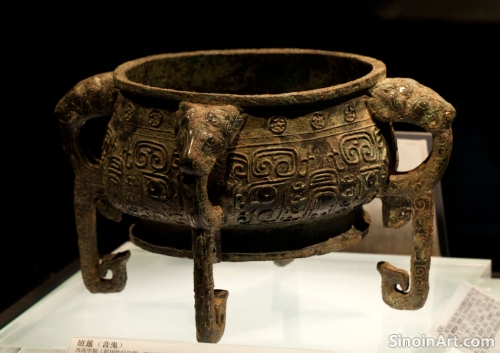The Influence of Bronze Ware on the Development of Chinese Calligraphy: Forms, Styles, and Materials
|
The creation of Chinese bronze ware, particularly the inscriptions found on these objects, had a reciprocal influence on the development of Chinese calligraphy, shaping the forms, styles, and even the tools and materials used in writing. The connection between bronze work and calligraphy helped to shape both artistic traditions. The careful control of line and form in bronze work also influenced the development of the forms of Chinese writing.  The early forms of Chinese characters, known as "bronze script" (jinwen), were initially developed for use on bronze objects, and their angular and stylized forms reflect the techniques of metal carving. The design of early Chinese script was heavily influenced by the technical requirements of writing on metal. The direct connection between the written word and the production of bronze is very clear in early Chinese writing.  The practice of carving inscriptions on bronze helped to establish the foundations for Chinese calligraphy, helping to create a system of strokes, proportions, and composition that would be further developed in later writing systems. The techniques used in working with bronze influenced the strokes and forms of written Chinese.  The evolution of different script styles over time, from the archaic bronze script to more formalized and fluid writing styles, reflects the changing aesthetic sensibilities and techniques that influenced both bronze work and calligraphy. The shared roots of both art forms help to illuminate the relationship between design and writing. The interplay between the art forms helped to shape both of them. |
Tag : bronze calligraphy influence, jinwen, Chinese writing history, ancient scripts, calligraphic styles
Related information
- The Use of Bronze in Ancient Chinese Water Management Systems: Irrigation and Hydraulic Engineering
- Bronze Ware and the Development of Ancient Chinese Agriculture: Water Management and Irrigation Systems
- The Future of Chinese Bronze Ware: New Discoveries, Research, and Interpretations
- Unveiling Ancient China: An Introduction to Chinese Bronze Ware
- Bronze Ware and Ancient Chinese Medical Practices: The Use of Instruments in Surgery and Healing
This article explores the use of bronze in ancient Chinese water management systems, highlighting its role in irrigation, hydraulic engineering, and the creation of tools and components that helped to control and manage water resources for agriculture.
This article explores the use of bronze in ancient Chinese agriculture, highlighting its role in creating water management systems, irrigation components, and other implements that were essential for increasing agricultural productivity and supporting a growing population.
This article explores the future of Chinese bronze ware studies, highlighting the potential for new discoveries, the use of advanced scientific techniques, new theoretical approaches, and how ongoing research will continue to enrich our understanding of these remarkable artifacts.
This article provides an introduction to Chinese bronze ware, exploring their creation, functions, cultural significance, and their enduring legacy as symbols of ancient China’s artistry and technological achievement.
This article explores the use of bronze in ancient Chinese surgical and medical practices, highlighting the creation of scalpels, needles, forceps, and other tools, and revealing the sophistication of ancient Chinese medical techniques.